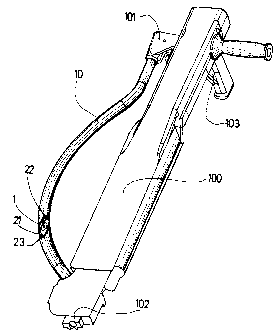Some of the information on this Web page has been provided by external sources. The Government of Canada is not responsible for the accuracy, reliability or currency of the information supplied by external sources. Users wishing to rely upon this information should consult directly with the source of the information. Content provided by external sources is not subject to official languages, privacy and accessibility requirements.
Any discrepancies in the text and image of the Claims and Abstract are due to differing posting times. Text of the Claims and Abstract are posted:
| (12) Patent: | (11) CA 2447011 |
|---|---|
| (54) English Title: | TUBE FOR FEEDING FASTENING ELEMENTS FOR A FASTENING APPARATUS |
| (54) French Title: | TUBE CONTENANT DES ELEMENTS DE FIXATION POUR ALIMENTER UN DISPOSITIF DE FIXATION |
| Status: | Expired and beyond the Period of Reversal |
| (51) International Patent Classification (IPC): |
|
|---|---|
| (72) Inventors : |
|
| (73) Owners : |
|
| (71) Applicants : |
|
| (74) Agent: | FINLAYSON & SINGLEHURST |
| (74) Associate agent: | |
| (45) Issued: | 2007-05-01 |
| (22) Filed Date: | 2003-10-27 |
| (41) Open to Public Inspection: | 2004-04-30 |
| Examination requested: | 2003-10-27 |
| Availability of licence: | N/A |
| Dedicated to the Public: | N/A |
| (25) Language of filing: | English |
| Patent Cooperation Treaty (PCT): | No |
|---|
| (30) Application Priority Data: | ||||||
|---|---|---|---|---|---|---|
|
The sealing apparatus (100) is used in a substantially
vertical position by the user, who inserts a magazine
pack containing nails into the hopper (101). After
unlocking of the hopper (101), the nails slide in the
flexible feed tube (10) as far as the front of a feeder
for indirect firing, in a buffer guide (102). The user
then merely has to actuate a trigger (103) in order to
entrain the nails into the support via the feeder. In
order to preserve the transparent quality of the tube
(10), its effective inner cross section (21) is not
circular, but is arranged (23) such that the contact
between the lateral wall of the circular head of the
nail (1) and the effective inner wall (21) of the tube
(10) is not possible on certain portions (22) of the
effective inner wall (21).
Note: Claims are shown in the official language in which they were submitted.
Note: Descriptions are shown in the official language in which they were submitted.

2024-08-01:As part of the Next Generation Patents (NGP) transition, the Canadian Patents Database (CPD) now contains a more detailed Event History, which replicates the Event Log of our new back-office solution.
Please note that "Inactive:" events refers to events no longer in use in our new back-office solution.
For a clearer understanding of the status of the application/patent presented on this page, the site Disclaimer , as well as the definitions for Patent , Event History , Maintenance Fee and Payment History should be consulted.
| Description | Date |
|---|---|
| Time Limit for Reversal Expired | 2011-10-27 |
| Letter Sent | 2010-10-27 |
| Grant by Issuance | 2007-05-01 |
| Inactive: Cover page published | 2007-04-30 |
| Inactive: Final fee received | 2007-02-19 |
| Pre-grant | 2007-02-19 |
| Notice of Allowance is Issued | 2006-08-21 |
| Letter Sent | 2006-08-21 |
| Notice of Allowance is Issued | 2006-08-21 |
| Inactive: Approved for allowance (AFA) | 2006-08-01 |
| Inactive: IPC from MCD | 2006-03-12 |
| Amendment Received - Voluntary Amendment | 2006-03-10 |
| Inactive: S.30(2) Rules - Examiner requisition | 2005-09-13 |
| Amendment Received - Voluntary Amendment | 2005-02-04 |
| Application Published (Open to Public Inspection) | 2004-04-30 |
| Inactive: Cover page published | 2004-04-29 |
| Letter Sent | 2004-02-13 |
| Inactive: Single transfer | 2004-01-20 |
| Inactive: First IPC assigned | 2003-12-23 |
| Inactive: IPC removed | 2003-12-23 |
| Inactive: IPC assigned | 2003-12-23 |
| Inactive: IPC removed | 2003-12-23 |
| Inactive: IPC assigned | 2003-12-23 |
| Inactive: IPC assigned | 2003-12-23 |
| Inactive: IPC assigned | 2003-12-23 |
| Inactive: IPC assigned | 2003-12-23 |
| Inactive: IPC assigned | 2003-12-23 |
| Inactive: Courtesy letter - Evidence | 2003-12-09 |
| Filing Requirements Determined Compliant | 2003-12-01 |
| Inactive: Filing certificate - RFE (English) | 2003-12-01 |
| Letter Sent | 2003-11-28 |
| Application Received - Regular National | 2003-11-28 |
| Request for Examination Requirements Determined Compliant | 2003-10-27 |
| All Requirements for Examination Determined Compliant | 2003-10-27 |
There is no abandonment history.
The last payment was received on 2006-10-03
Note : If the full payment has not been received on or before the date indicated, a further fee may be required which may be one of the following
Please refer to the CIPO Patent Fees web page to see all current fee amounts.
| Fee Type | Anniversary Year | Due Date | Paid Date |
|---|---|---|---|
| Application fee - standard | 2003-10-27 | ||
| Request for examination - standard | 2003-10-27 | ||
| Registration of a document | 2004-01-20 | ||
| MF (application, 2nd anniv.) - standard | 02 | 2005-10-27 | 2005-10-03 |
| MF (application, 3rd anniv.) - standard | 03 | 2006-10-27 | 2006-10-03 |
| Final fee - standard | 2007-02-19 | ||
| MF (patent, 4th anniv.) - standard | 2007-10-29 | 2007-10-01 | |
| MF (patent, 5th anniv.) - standard | 2008-10-27 | 2008-09-30 | |
| MF (patent, 6th anniv.) - standard | 2009-10-27 | 2009-10-01 |
Note: Records showing the ownership history in alphabetical order.
| Current Owners on Record |
|---|
| SOCIETE DE PROSPECTION ET D'INVENTIONS TECHNIQUES SPIT |
| Past Owners on Record |
|---|
| ALAIN VETORETTI |
| PATRICK HERELIER |